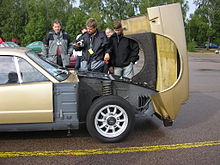Hood (car): Difference between revisions
No edit summary |
No edit summary |
||
| Line 6: | Line 6: | ||
The '''bonnet''' (UK and rest of world) or '''hood''' (US) is the [[hinged]] [[lid (container)|cover]] over the [[engine]] of [[motor vehicle]]s that allows access to the engine compartment for maintenance and [[auto mechanic|repair]]. In British terminology, ''hood'' refers to a fabric cover over the passenger compartment of the car (known as the 'top' in the US). In many motor vehicles built in the 1930s and 1940s, the resemblance to an actual hood or bonnet is clear when open and viewed head-on; in modern vehicles it continues to serve the same purpose but no longer resembles a head covering. |
The '''bonnet''' (UK and rest of world) or '''hood''' (US) is the [[hinged]] [[lid (container)|cover]] over the [[engine]] of [[motor vehicle]]s that allows access to the engine compartment for maintenance and [[auto mechanic|repair]]. In British terminology, ''hood'' refers to a fabric cover over the passenger compartment of the car (known as the 'top' in the US). In many motor vehicles built in the 1930s and 1940s, the resemblance to an actual hood or bonnet is clear when open and viewed head-on; in modern vehicles it continues to serve the same purpose but no longer resembles a head covering. |
||
On passenger cars, a hood may be held down by a concealed latch. On race cars or cars with aftermarket hoods (that do not use the factory latch system) the hood may be held down by hood pins. A hood may sometimes contain a [[hood ornament]], [[hood scoop]], [[power bulge]], and/or [[windscreen wiper|wiper]] jets. Hoods are typically made out of [[steel]], but [[aluminium]] is rapidly gaining popularity with auto companies. Aftermarket manufacturers may construct hoods out of [[fiberglass]], [[carbon |
On passenger cars, a hood may be held down by a concealed latch. On race cars or cars with aftermarket hoods (that do not use the factory latch system) the hood may be held down by hood pins. A hood may sometimes contain a [[hood ornament]], [[hood scoop]], [[power bulge]], and/or [[windscreen wiper|wiper]] jets. Hoods are typically made out of [[steel]], but [[aluminium]] is rapidly gaining popularity with auto companies. Aftermarket manufacturers may construct hoods out of [[fiberglass]], [[carbon fibre]], or dry carbon. |
||
In [[Japan]] and [[Europe]], regulations have come into effect in recent years that place a limit on the severity of pedestrian head injury when struck by a motor vehicle. This is leading to more advanced hood designs, as evidenced by multicone hood inner panel designs as found on the [[Mazda RX-8]] and other vehicles. Other changes are being made to use the bonnet / hood as an active structure and push its surface several cm away from the hard motor components during a pedestrian crash. This may be achieved by mechanical (spring force) or [[pyrotechnic]] devices. |
In [[Japan]] and [[Europe]], regulations have come into effect in recent years that place a limit on the severity of pedestrian head injury when struck by a motor vehicle. This is leading to more advanced hood designs, as evidenced by multicone hood inner panel designs as found on the [[Mazda RX-8]] and other vehicles. Other changes are being made to use the bonnet / hood as an active structure and push its surface several cm away from the hard motor components during a pedestrian crash. This may be achieved by mechanical (spring force) or [[pyrotechnic]] devices. |
||
Revision as of 21:16, 2 January 2012


The bonnet (UK and rest of world) or hood (US) is the hinged cover over the engine of motor vehicles that allows access to the engine compartment for maintenance and repair. In British terminology, hood refers to a fabric cover over the passenger compartment of the car (known as the 'top' in the US). In many motor vehicles built in the 1930s and 1940s, the resemblance to an actual hood or bonnet is clear when open and viewed head-on; in modern vehicles it continues to serve the same purpose but no longer resembles a head covering.
On passenger cars, a hood may be held down by a concealed latch. On race cars or cars with aftermarket hoods (that do not use the factory latch system) the hood may be held down by hood pins. A hood may sometimes contain a hood ornament, hood scoop, power bulge, and/or wiper jets. Hoods are typically made out of steel, but aluminium is rapidly gaining popularity with auto companies. Aftermarket manufacturers may construct hoods out of fiberglass, carbon fibre, or dry carbon.
In Japan and Europe, regulations have come into effect in recent years that place a limit on the severity of pedestrian head injury when struck by a motor vehicle. This is leading to more advanced hood designs, as evidenced by multicone hood inner panel designs as found on the Mazda RX-8 and other vehicles. Other changes are being made to use the bonnet / hood as an active structure and push its surface several cm away from the hard motor components during a pedestrian crash. This may be achieved by mechanical (spring force) or pyrotechnic devices.
